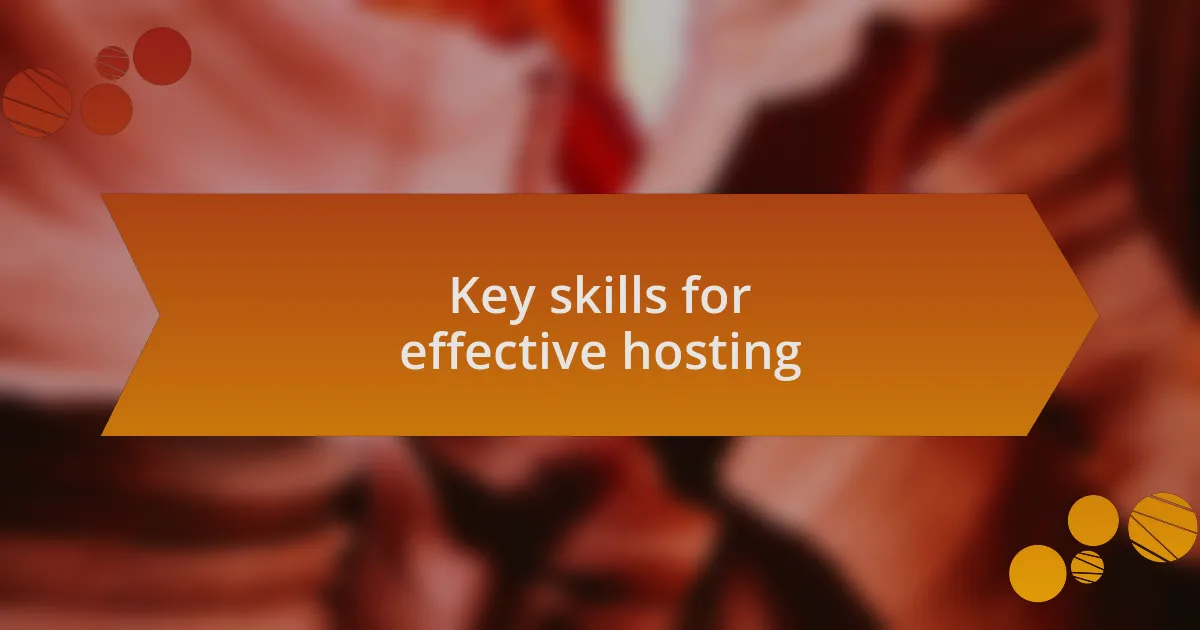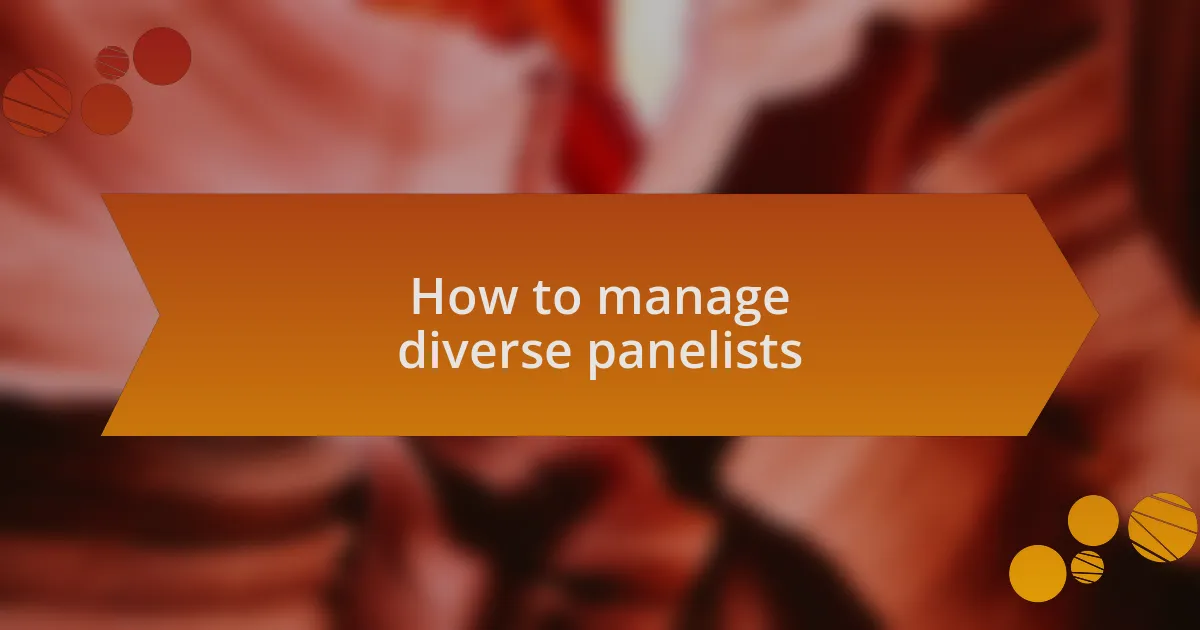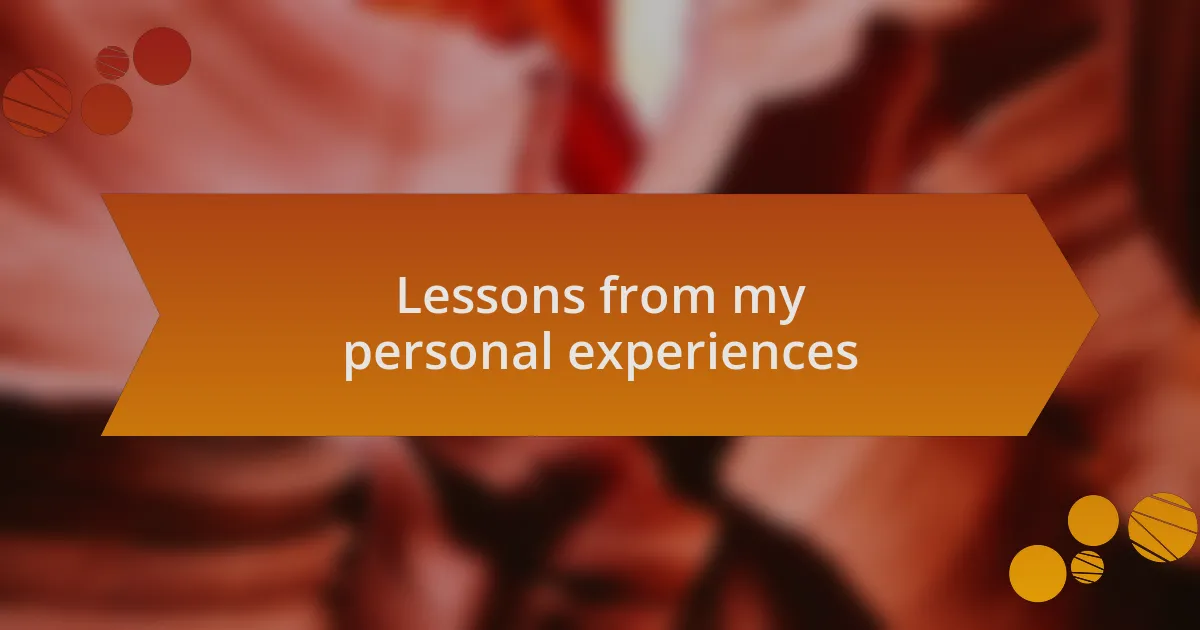Key takeaways:
- Panel hosting fosters community by engaging artists and sharing personal stories, which can lead to deeper connections and discussions.
- Effective hosting requires strong communication skills, adaptability to unique panel dynamics, and creating a welcoming atmosphere for all participants.
- Managing diverse panelists involves recognizing their unique perspectives, creating a safe space for dialogue, and mediating discussions to ensure equitable participation.
- Preparation and feedback are essential for successful events, as they help anticipate challenges and improve future panel experiences based on audience insights.

Understanding panel hosting benefits
One of the most rewarding aspects of hosting panels is the chance to engage directly with artists and art enthusiasts. I remember a panel I hosted where a seasoned painter shared her journey through the challenges of self-doubt. Hearing her speak about vulnerability resonated deeply with the audience, demonstrating how such intimate discussions can foster a sense of community and shared experience within the art world.
Panel hosting also offers valuable networking opportunities. Reflecting on my experience, I can say that many meaningful connections stemmed from casual conversations after the panels. These conversations often led to collaboration ideas and future projects. When was the last time you met someone who inspired you in ways you didn’t expect?
Moreover, hosting panels can elevate your personal brand or that of your gallery. I’ve noticed that after organizing discussions, our gallery’s visibility increased, leading to more visitors and new partnerships. Doesn’t it feel amazing to see your efforts create tangible benefits that extend beyond just one event?

Key skills for effective hosting
Effective hosting hinges on strong communication skills. From my experience, clarity and enthusiasm in conveying ideas can set the tone for the entire panel. I recall a moment when I struggled to find the right words during a discussion. It was a turning point for me, highlighting how crucial it is to articulate thoughts in a way that resonates with the audience.
Another essential skill is adaptability. Each panel is unique, and sometimes discussions veer off-script. I have learned to embrace these moments. For example, during one panel, a heated debate erupted about art censorship, shifting the flow completely. Navigating that conversation not only engaged the audience more but also added depth to the event.
Lastly, fostering a welcoming atmosphere is vital. I’ve found that the most memorable panels are those where attendees feel comfortable sharing their thoughts. I often make a point to invite audience questions early on. Creating that sense of openness encourages participation and transforms the event into a true dialogue rather than a one-sided conversation. Have you ever noticed how much richer a discussion becomes when everyone feels empowered to contribute?

Techniques for engaging discussions
Engaging discussions often hinge on how well you can spark curiosity among participants. I like to start with open-ended questions that invite exploration rather than just yes or no answers. One time, I posed a seemingly simple question about the story behind a particular painting, and it turned into a rich, layered dialogue. It reminded me that sometimes the smallest prompts can lead to the most profound conversations.
Another technique I’ve found effective is to weave personal stories into the discussion. For instance, sharing a personal experience related to a piece of artwork not only humanizes the conversation but also encourages others to share their own stories. I once shared my first encounter with a striking sculpture, and suddenly, panelists began revealing their emotional connections to art. How often do we connect with others through shared experiences?
Moreover, maintaining an element of playfulness can lighten the mood and keep the audience engaged. I remember one panel where we included a quick interactive segment asking the audience to guess the inspiration behind various works. Laughter and insights flowed freely, reminding me that a little fun can break down barriers and open the floor for deeper discussion. Isn’t it fascinating how humor can turn a formal setting into a lively exchange?

How to manage diverse panelists
Managing diverse panelists can be a rewarding challenge. It’s essential to recognize the unique perspectives each participant brings to the table. I remember a panel where we had artists from various cultural backgrounds, and it quickly became apparent that their differing viewpoints enriched the conversation. When I made an effort to highlight these differences and encourage everyone to express their views, the dialogue blossomed into an insightful exchange about how culture influences artistic expression.
One technique I’ve found particularly helpful is creating a safe space for all voices. Early on in my hosting experience, I noticed that quieter panelists often struggled to share their thoughts. To address this, I began incorporating “round-robin” format discussions, ensuring everyone had a chance to speak. This not only balanced the conversation but also allowed for deeper connections among the panelists, reinforcing the idea that every voice matters. Have you ever noticed how a simple alteration in format can facilitate a richer discussion?
Additionally, I believe that being proactive in mediating discussions is vital. I take time to read the room, watching for non-verbal cues and engagement levels. During one memorable session, I sensed a panelist becoming overshadowed by a more dominant voice. So, I gently redirected the conversation back to them, asking for their perspective. That moment created not just a more equitable discussion but also encouraged the group to appreciate the richness that arises from diverse viewpoints. Isn’t it fascinating how simple attentiveness can transform a dialogue?

Creating a welcoming atmosphere
Creating a welcoming atmosphere is essential for fostering genuine connections between panelists and the audience. I recall a panel where I placed a small welcome sign at the entrance, along with name tags for both the speakers and attendees. This small gesture instantly broke the ice, making it easier for everyone to mingle and feel like they belonged. Have you ever walked into an event and felt that instant warmth? It sets the tone for what’s to come.
While organizing events, I’ve learned that the physical space plays a significant role in how inviting an atmosphere feels. In one panel I hosted, we arranged the seating in a circular format, rather than traditional rows. This simple adjustment made participants feel more included, as if they were part of a shared conversation rather than spectators. Whenever I see panelists leaning in and exchanging animated conversations, I can’t help but think about how the environment fosters authentic engagement.
It’s also crucial to remember the power of personal touches. During a recent panel, I offered a small refreshment table with light snacks and drinks. The informal setting created opportunities for casual chat before the event began. Seeing participants laugh and mingle while sharing stories brought them closer together, and I found that these moments often led to richer dialogues during the discussions. Have you ever noticed how a little hospitality can spark meaningful connections?

Lessons from my personal experiences
One of the biggest lessons I learned while hosting panels is the importance of preparation. There was one event where I underestimated the time needed for a tech check. The microphone malfunctioned just minutes before we started, and the frantic moments that followed taught me the value of being proactive. Have you ever felt that rush of anxiety? Now, I always make it a point to arrive early and test every piece of equipment, ensuring a smooth start.
Another invaluable lesson arose from observing my panelists. During one discussion, a quiet panelist opened up after I encouraged questions from the audience. I realized then that sometimes, it takes just a little nudge to reveal valuable insights. It made me think: how often do we overlook quieter voices in a conversation? Since then, I’ve made it a priority to create a space where everyone feels empowered to share their thoughts.
Finally, I’ve learned that feedback is a powerful tool. After one event, I sent out a quick survey to attendees, asking what they enjoyed and what could be improved. The responses provided me with unexpected gems, such as the need for more interactive elements. It reminded me that listening to the audience not only enhances future events but also fosters a community where attendees feel valued. Have you ever considered how feedback can shape your experiences?